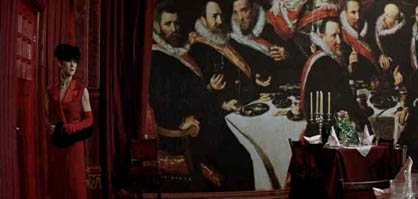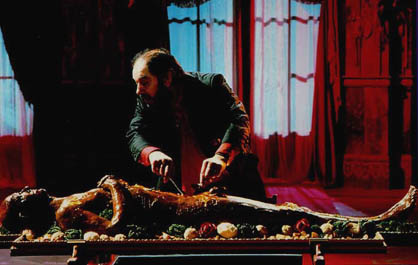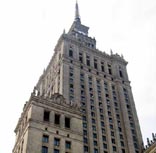|
|
| home > movies |
| An
interview with Peter Greenaway Ania Krenz |
| If
I ever believed in reincarnation and I wanted to come down again, I
would very much like to be an architect. Peter Greenaway |
||||
| ANIA
KRENZ: In your films you put a lot of attention to architecture and
interiors. What is the role of architecture in your films? PETER GREENAWAY: Maybe it has something to do with an antagonism about the medium itself. Film is supposedly 2-dimensional, but it also has the ability to move. And so I think you can get a sense of space and 3-dimensionality by the movement. If I ever believed in reincarnation and I wanted to come down again, I would very much like to be an architect, for very obvious reasons.  In some ways because architecture is the ultimate multimedia and it creates the situation which exists for everyday 9-5 living. You can forget cinema, you can go through life without worrying about a painting, you can even, although impoverish your life by not listening to music, but you cannot avoid architecture. We need it, it is one of the essential elements. Certainly in the northern hemisphere is shelter. And a shelter, in a sense, is the basic level of architectural situation. ANIA KRENZ: While films are 2-dimensional (the screen) with a third dimension, which is time, how can you relate to space itself? How a perfect combination can be achieved? PETER GREENAWAY: Well, through movement. In The Cook, the Thief, his Wife and her Lover, which is full of very grand architectural movements, slow progression, in an artificial way, because when we walk through a building, we are on the move, there is the ability of a dolling camera which is on the rails to have a series of very composed pictures constantly, so it is an ideal way of looking at architecture. It is also distance too, because, in a sense, you can participate in architecture, but you are not involved in it. For example you do not have to look where your feet are going, which is a tremendous advantage, you just have to worry what the heck is the brain doing. ANIA KRENZ: In films there is a linear way of looking at architecture and in real life people are looking all around. PETER GREENAWAY: I developed for myself a phonic vocabulary which is very much about distance. And there are all sorts of reasons for that. I was trained as a painter. And I especially admire what can be described as classical painters. People like Poussin, like della Francesca, in modern terms people like Mondrian, Sol Le Witt, and they have a sort of a very apollonian view of the world, which has very much to do with balance and symmetry and order. And if you look at most of my films, they are apollonian, they are not dionisian, and they would deal essentially in classical architecture.  So as much as I like Libeskind or Gehry, who are very dionisian, they are not very apollonian, there is still a way that I personally would move far more to the modernists than to postmodernists, because of this sense of order sense of proportion. Although I think, again, the excesses of Modernism have completely misinterpreted scale. ANIA KRENZ: Most of the contemporary buildings have no proper scale nor proportions like the classical architecture used to have. Most of them are just too big. PETER GREENAWAY: They are totalitarian, again. It is sort of back to architectural fascism. I live in probably one of the most satisfactory cities in the world, which is Amsterdam, which is really extremely well-built. It has the best domestic architecture, I think, probably anywhere in Europe. Maybe there are better examples, maybe the ancient Aztecs or so. But in terms of European traditions there is a relationship between buildings, streets, spaces and people which is very satisfactory in Amsterdam. ANIA KRENZ: I admire the beautiful and relatively high windows in Amsterdam due to the narrow houses and lack of proper daylight. PETER GREENAWAY: But there are problems because most of the buildings only work North-South, they do not work East-West, because the organisation of canals' system. So a lot of the interiors of the buildings are very dark because there is no window space. The windows are always on the front or always on the back. But other thing is that non of the buildings is more than 5 storeys high maximum, which I think is important. Because once you get above that ...you know, I hate using lifts. I want to go everywhere in architecture with my feet. So therefore the skyscraper is very problematical. You know, maybe the greatest disaster on 11th of September was the fact that the people could not use the stairs. ANIA KRENZ: ... hm... PETER GREENAWAY: And yet I am fascinated by the notion of the tower. You know, the tower, because it is a bit like a dwarf on the shoulders of the giant. And you think about all these north Italian cities, like San Gimignano, or all those places, which are really Manhattans made of brick in the 11th Century. This is great desire to build towers all the time. Which, I suppose, is particular maybe male, penis-association, if you want to produce these sort of metaphors. ANIA KRENZ: It is interesting that there are many architectural theories, especially feminist, which compare towers to ...phalluses. PETER GREENAWAY: Well, we are in a post-Freudian age. We are trained to think in that way. So maybe the gender differences are under historical collaboration. And I think people in the 14th Century thought about towers as being penis substitutes. ANIA KRENZ: They wanted to show how high can they go! PETER GREENAWAY: It is the status of Ego. ANIA KRENZ: What is your favourite building? PETER GREENAWAY: Ah, the Pantheon in Rome always gives me enormous amounts of delight. Insides, outsides, the beautiful combination of Platonic solids, triangles, squares, the sphere. Contemporary buildings, I suppose, I would have to say Libeskind's Jewish Museum in this city [Berlin]. I always admire mostly.  My taste is very, very catholic. Often I like very modest buildings which do not get into architectural books. I will say, generally, domestic architecture from 1650 right up till, I suppose, the last year in Amsterdam. Continuously the Dutch are capable of revitalising domestic architecture. Maybe it is because of their building material, which is brick. You can manipulate brick in a way that you cannot manipulate the more august and noble elements like stone etc. But the concrete... happily the Dutch have avoided concrete. Which maybe is rather significant. Because so many of the ugliest buildings, look at these pillars [in House der Kulturen der Welt] in the world are concrete. ANIA KRENZ: In The Cook, the Thief, his Wife and her Lover there are scenes when the female character goes through different rooms, which have different colours, the colour of her dress changes also. What was the idea of colour simultaneous changes of interiors and clothes? What is the role of colour in architecture and films? PETER GREENAWAY: Well, first of all, I was trained as a painter. And colour is very important in painting. And colours hardly seem to interest filmmakers at all or very superficially. Almost like a sort of IKEA-habitat interior design quality. But not structurally because the colour coding is so significant. You know, emotionally and suggestively and associatively and historically. And I wanted to be able to use that language in a very rich way. But I needed to say: "Look, people! Look, look, look! This is about colour!" so deliberately I used these devices about people changing to fit their environment... as an attempt to get people to look. Because most people do not use their eyes. Most people are visually illiterate. ANIA KRENZ: It is the role of films to show what is usually unseen, especially within architecture. PETER GREENAWAY: Well, architecturally the tradition is that people never look above the 1st storey. ANIA KRENZ: In your films you always combine few elements of interest, and from then on, you build up a story or plot. For example in the "Belly of an Architect" there was architecture, an architect and a belly... obviously there is something with architects and their bellies. But what is it? PETER GREENAWAY: it is the centre of gravity. The gravity is here, in the belly. ANIA KRENZ: And what is the idea of systems of different elements that you play around in your films? PETER GREENAWAY: I guess it is a general set of practice. I do not think we have seen any cinema, all I think we have seen is a 107 years of illustrated text. In every film you ever seen you a director following the text and creating images as an afterthought. Therefore I try to find a way to make a cinema which is non-narrative. Narrative belongs in books. It doesn't belong to cinema. Cinema is a very poor narrative medium.  I try to find alternative systems in which to hold the material together. Numerical systems and alphabetical systems, for the first time in history of the world are now universal. The Japanese, the Eskimos, everybody understands numerical decimal system. Everybody basically understands alphabetical systems. They might be absurd, they might be limited, but your medical records, your police records, academia is all based on the alphabet. That is how you find things. That is how our libraries are organised. So people know about these systems. And they are, of course, I suppose, non-narrative. Maybe a, b, c, d... is a sort of a narrative but it is really very primitive knot. I try to find ways to organise the movies in non-narrative subjects. It's difficult, because most people are used to go the cinema to be told stories, but I think I want to try to make them un-learn that habit. Because cinema is essentially about sequence, not about narrative. You can't have narrative without sequence. But you can easily have sequence without narrative. So these are sort of general principles, on which I try to base my cinema. And you will know that 2 systems that deal in these subject matters are architecture and music. The way the music and architecture have enormous amounts of infinity. And architecture works that way, and works that way. And music works that way, and works that way. ANIA KRENZ: The narrative systems were systems we were taught. These are systems people can follow in linear way. In sequences it is quite different. Are people sensitive to sequential perception? PETER GREENAWAY: Our education systems kill all of that. We are all very sophisticated in handling text. Most people are visually and architecturally illiterate. People's attention has to be drawn to such a phenomenon called space. And I like that, you know, I like scale and space. I work a lot with dancers, because dancers understand space, the relationships, the shudders, the weight. The phenomenon of gravity is very important in terms of architecture. ANIA KRENZ: What was the reason that you co-operated with Michael Nyman, who had composed music to some your films? PETER GREENAWAY: ...hm, we used to, once upon a time. I think it was a particular combination between classical English music like Percel and Haendel, that he was based in, associated with minimal music of people like Philip Glass etc. My 2 enthusiasms came together with him. But I sort of think that Michael Nyman, being extremely intelligent and self-conscious, has a sense of irony in his music, and that is unusual in music. Music is not very good in handling irony. Music is difficult to pastiche itself. It is too pure form. The other extraordinary thing about music is that it can be highly emotional and also incredibly abstract at the same time. So that is a clever ability to create huge emotional effect out of mathematics. ANIA KRENZ: Do you know anything about Polish architecture? |
[27apr2003]
|
|||
 |
PETER
GREENAWAY: I know terrible things like trying to reproduce mediaeval
city in Cracow, which I think is totally waste of time. Things like
that. I have been to Warsaw several times, I love that soviet palace
of entertainment, that you have in the middle. I wanted to film in the
swimming-pool underneath but I couldn't get the permission. But again,
maybe it is politically most unacceptable, but I enjoy fascist architecture.
I think the fascist architecture of Italy, for example Rome, is extraordinary.
And admire Albert Speer, as well. Mainly because it goes back to Étienne-Louis
Boullée, of whom I obviously made a feature in the "Belly
of an Architect". So it has to do with near classical revival,
basic and prompt of Platonic solids. ANIA KRENZ: After seeing Belly of an Architect... whenever I come out from the train station in Warsaw, and see the Palace of Culture, I clap. It is such an powerful building. I clap exactly like the people in the Belly of an Architect while seeing adorable architecture. PETER GREENAWAY: I think we should clap architecture. ANIA KRENZ: to the Palace of culture in Warsaw... PETER GREENAWAY: It is like a cathedral which is like Amiens or Chartres or whatever else. It is also well-built. It will not fall down very easily. |
|||